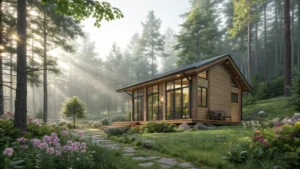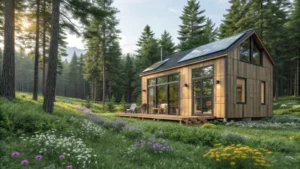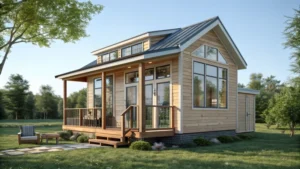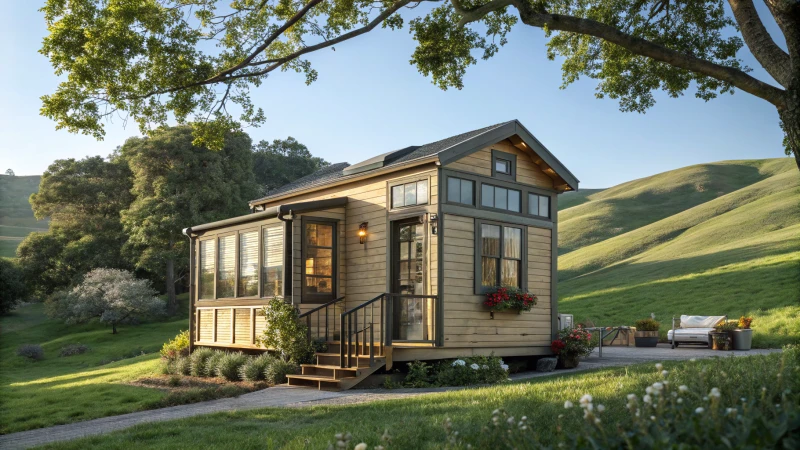
Dreaming of a cozy, minimalist lifestyle in California? You're not alone! Let's explore the journey to owning a tiny home in this vibrant state.
In California, tiny homes typically cost between $50,000 and $200,000. Standard models range from $50,000 to $120,000, while custom designs can go beyond $150,000, depending on size and personalization.
When I first started looking into tiny homes, I was drawn to their simplicity and affordability compared to traditional housing. However, I quickly realized that the price tag isn't the whole story. There are so many factors that influence the final cost of living tiny in California. From the high land prices in cities like Los Angeles and San Francisco to the added expenses of site preparation and utilities hookups, each decision impacts the bottom line. And let's not forget about long-term costs like property taxes and maintenance. Understanding these factors can help you create a realistic budget for your tiny home dream.
Tiny homes in California start at $50,000.True
The article states that standard models typically cost from $50,000.
Custom tiny homes in California never exceed $150,000.False
Custom designs can exceed $150,000 as stated in the article.
Why Does Location Matter for Tiny Home Prices in California?
Ever wonder why tiny home prices in California swing so wildly? The secret lies in the location, and it’s more impactful than you might think.
Location plays a crucial role in determining tiny home prices across California. In urban areas like San Francisco or Los Angeles, high demand and expensive land push prices up, while rural regions offer more budget-friendly options.
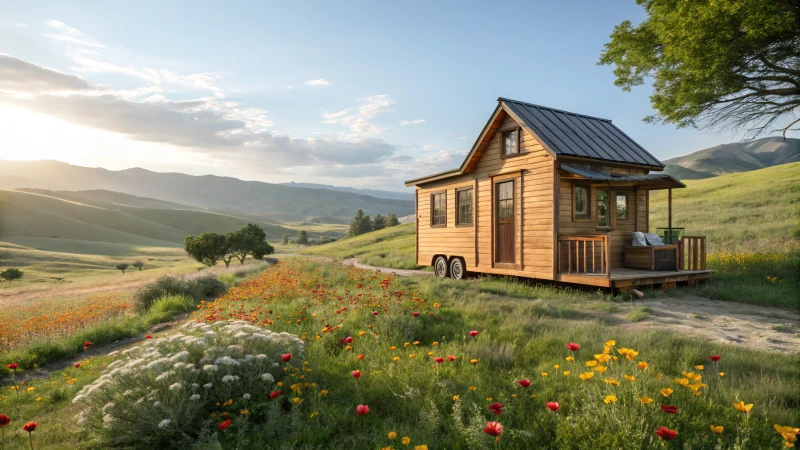
The Urban Premium
I remember the first time I considered a tiny home in San Francisco—it was a dizzying realization of how location can dictate costs. San Francisco, Los Angeles, and San Diego are notorious for their sky-high living expenses. Tiny homes here aren't just small; they're compact with a price to match. In these bustling cities, you're not just paying for the space; you're investing in the lifestyle, the opportunities, and the vibrant culture at your doorstep. Prices often hover between $100,000 to $200,000 or even more. It's all about proximity to those hip cafes, tech jobs, and yes, the infamous traffic.
| City | Average Price | Factors |
|---|---|---|
| San Francisco | $150,000 - $200,000 | High demand, limited space |
| Los Angeles | $120,000 - $180,000 | Entertainment industry influence |
| San Diego | $110,000 - $170,000 | Desirable climate, tech hub |
The Rural Retreat
Then there's the charm of rural California—a different world entirely. I’ve always been drawn to the idea of waking up to serene landscapes and wide-open spaces. Here in places like the Central Valley or Northern California, life slows down a bit, and so do the costs. Tiny homes in these tranquil regions can cost anywhere from $40,000 to $100,000. The land is cheaper and there's more of it—plus fewer headaches with zoning regulations1. It’s about embracing simplicity and enjoying the flexibility that comes with it.
Coastal Considerations
And who could resist the call of California's stunning coastline? The dream of a tiny home with an ocean view is compelling. But let’s face it—the scarcity of land and environmental regulations add layers of complexity and cost. Coastal towns offer tiny homes in the $80,000 to $150,000 range. These spots are a slice of paradise but come with their own set of challenges and price tags due to environmental regulations2.
Comparative Analysis
Here's a quick look at how location can make all the difference:
| Region | Price Range | Influencing Factors |
|---|---|---|
| Urban (e.g., LA) | $120k - $200k | High demand, proximity to services |
| Rural (e.g., Central Valley) | $40k - $100k | Lower land costs, relaxed zoning |
| Coastal (e.g., Santa Cruz) | $80k - $150k | Scenic views, limited availability |
Understanding these nuances helps me guide potential buyers through the maze of options available. Exploring various financing options3 can also be a game-changer in navigating these diverse pricing landscapes effectively.
Urban tiny homes in California cost over $100,000.True
Urban centers have high demand and land costs, raising tiny home prices.
Rural tiny homes in California exceed $150,000.False
Rural areas have lower demand and land costs, reducing prices.
What Are the Hidden Costs of Building a Tiny Home?
Thinking of embracing the tiny home lifestyle? It's not all sunshine and savings—hidden costs lurk beneath the surface. From zoning to utilities, planning ahead is crucial.
Building a tiny home comes with hidden costs like zoning compliance, utility hookups, and ongoing maintenance. These often-overlooked expenses can significantly impact your budget, making thorough planning and research essential.
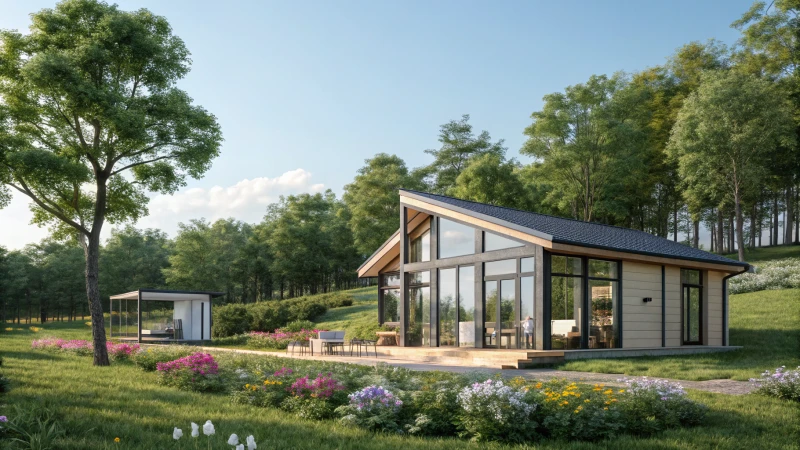
Zoning and Regulatory Costs
Before you even start building, it's essential to navigate zoning laws and building codes. These regulations can be a significant hurdle and vary widely by region4. In some areas, tiny homes are classified as accessory dwelling units (ADUs), requiring specific permits. Depending on where you are, these permits can range from $500 to a whopping $5,000.
| Regulatory Element | Potential Cost |
|---|---|
| Zoning Permits | $500 - $5,000 |
| Inspection Fees | $200 - $1,500 per visit |
Doing thorough research on local regulations can save you from expensive surprises later on.
Utility Connection Expenses
Connecting utilities was another unexpected expense. Initially, I imagined hooking up water, electricity, and sewage would be straightforward and cheap. However, if your tiny home is on wheels or in a remote location, consider the cost of mobile hookups5 or off-grid systems6.
| Utility Type | Connection Cost |
|---|---|
| Water | $2,000 - $5,000 |
| Electricity | $1,500 - $3,500 |
| Sewage/Septic | $3,000 - $6,000 |
These costs can vary greatly depending on your location and proximity to main lines.
Site Preparation and Foundation
Even if you’re opting for a prefabricated model, don't underestimate site preparation costs. When I cleared land and prepared the foundation, the expenses added up fast.
| Preparation Activity | Estimated Cost |
|---|---|
| Land Clearing | $500 - $3,000 |
| Foundation Installation | $5,000 - $8,000 |
Geographical factors like slope or soil type can dramatically affect these costs.
Insurance and Long-Term Maintenance
Insuring my tiny home wasn't as straightforward as I thought. It turns out whether your home is stationary or mobile affects your coverage options. You may need specialized coverage7. Annual premiums ranged from $500 to $1,500.
And then there's maintenance. While tiny homes generally need less upkeep than traditional homes, regular attention is crucial to avoid costly repairs. Consider allocating funds for:
- Roof repairs
- Plumbing maintenance
- Pest control
each aspect adds to the long-term financial commitment of owning a tiny home.
Understanding these hidden costs is vital for making informed decisions about your tiny home journey. Whether it's buying land or opting for off-grid solutions every choice impacts your overall budget. Keep these considerations in mind as you plan your dream tiny dwelling.
Zoning permits for tiny homes can cost up to $5,000.True
Depending on the jurisdiction, zoning permits range from $500 to $5,000.
Foundation installation for tiny homes costs over $10,000.False
Foundation installation costs between $5,000 and $8,000.
Can You Finance a Tiny Home Like a Traditional House?
Ever wondered if you can finance a tiny home just like a regular house? Let's explore the ins and outs of tiny home financing and uncover your best options.
Yes, you can finance a tiny home like a traditional house if it meets certain criteria, such as being on a permanent foundation. Other options include personal loans and RV loans for mobile tiny homes.

Understanding Tiny Home Financing Options
I remember the first time I considered downsizing to a tiny home. The allure of simplicity and cutting down on unnecessary clutter was overwhelming. But then, like many others, I hit the wall of financial reality. Navigating the financing options for tiny homes can be a bit like walking through a maze.
Tiny homes have surged in popularity because they're not just cost-effective; they offer an entirely different lifestyle. But securing the right financing is crucial. Typically, lenders will insist that your tiny home is on a permanent foundation8 to qualify for a mortgage, thus classifying it as real property.
Mortgage Possibilities for Tiny Homes
If your tiny home is permanently set up and adheres to local building codes, you're in luck! Some lenders might actually offer you a conventional mortgage. It's a bit like hitting the jackpot—lower interest rates and longer repayment terms sound dreamy, right? But remember, the catch is that your home must qualify as real estate.
Alternative Financing Options
For those charming little abodes on wheels or not firmly anchored to the ground, personal loans could be the way to go. I know from experience that these loans often come with higher interest rates, but they also tend to be less picky about what type of property you're investing in. The key here is your creditworthiness.
| Financing Option | Interest Rate | Term Length | Eligibility Requirements |
|---|---|---|---|
| Mortgage | Lower | Up to 30 years | Permanent foundation, meets building codes |
| Personal Loan | Higher | 2-7 years | Based on credit score, unsecured |
| RV Loan | Moderate | 5-20 years | For mobile tiny homes with RV certification |
RV Loans for Mobile Tiny Homes
Now, if your tiny house dreams involve wheels and endless horizons, an RV loan might be your ticket. Moderate interest rates and longer terms make these loans appealing. However, lenders will likely require your home to have RV certification.
Factors Influencing Financing Decisions
Lenders don’t just hand out loans without a good look at several factors:
- Location: Homes in high-demand areas often have more financing options.
- Home Type: Modular or prefabricated homes may qualify for different loans.
- Customization and Features: High-end customizations could impact loan amounts.
Doing thorough research on various lenders9 and understanding their specific criteria for tiny homes is crucial. Different lenders have different takes on tiny homes, so terms can vary based on individual circumstances and property specifics.
Exploring various financing avenues allows potential buyers like us to find the perfect fit for our unique needs and financial situations. This helps us secure the homes of our dreams without unnecessary financial pressure.
To navigate this unique lending landscape effectively, it might be wise to consult with financial advisors or real estate experts familiar with tiny home financing. They can offer insights into potential pitfalls and opportunities, ensuring a smoother purchasing process. Thorough research10 is essential to make informed decisions that align with our goals and financial capabilities.
Tiny homes on wheels can qualify for traditional mortgages.False
Traditional mortgages require homes to be on permanent foundations.
RV loans are suitable for mobile tiny homes.True
RV loans are designed for mobile homes with RV certification.
What Long-Term Expenses Should Tiny Home Owners Expect?
Owning a tiny home is an adventure in minimalism, but understanding the costs can help avoid unexpected financial hurdles. Let's dive into what long-term expenses you should anticipate on your tiny home journey.
Tiny home owners should budget for property taxes, maintenance, insurance, and utilities. These expenses can vary greatly depending on location, home type, and lifestyle. Proper planning ensures a sustainable and enjoyable tiny home living experience.
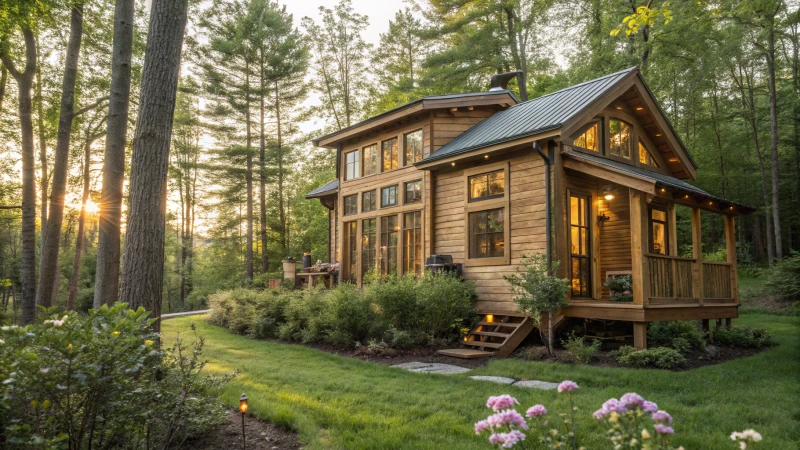
I remember when I first embarked on my tiny home journey—excited but also a tad apprehensive about the long-term costs. Initially, I thought living small would mean spending less. While that's true to an extent, there are still several key expenses to plan for, ensuring my dream of a minimalist lifestyle didn't become a financial nightmare.
Property Taxes: A Necessary Obligation
Despite their size, tiny homes are not exempt from property taxes. When I parked my home in a high-value area, I realized that taxes could be surprisingly hefty. It's crucial to check the rates in your chosen location, especially if your tiny home is on a permanent foundation. For instance, in areas with high property values11, expect taxes to mirror those of conventional homes.
Maintenance: Keeping Your Tiny Home in Shape
Even though maintenance is generally less costly than with larger homes, I learned the hard way that traveling with a mobile unit can lead to wear and tear, especially during harsh weather conditions. Regular checks and minor repairs prevent more significant issues, like when a small leak turned into a full-blown roof repair.
| Maintenance Aspect | Estimated Cost |
|---|---|
| Roof Repairs | $300 - $1,000 |
| Floor Replacement | $500 - $1,500 |
| Exterior Paint | $200 - $600 |
Insurance: Protecting Your Investment
Insurance is another must-have. I spent a good amount of time comparing different policies to find one that best suited my situation. Whether your tiny home is stationary or mobile greatly influences the type of insurance you'll need. Stationary homes might require standard homeowners insurance, while mobile units could need an RV policy. Annual premiums range from $500 to $1,500. It's essential to compare policy options12 for the best coverage.
Utilities: Managing Consumption in a Tiny Space
While utility bills are typically lower in a tiny space, I found that lifestyle choices significantly affect costs. Investing in solar panels and energy-efficient appliances helped me keep expenses down. However, getting hooked up to the grid came with its own set of fees which caught me off guard initially. Check local utility rates13 for better budgeting.
Unexpected Costs: Be Prepared
Lastly, always prepare for the unexpected. From zoning disputes to moving costs if you decide to relocate, having an emergency fund is invaluable. I learned this lesson after an unexpected move due to zoning changes that required legal consultation—an expense I hadn't initially budgeted for. The importance of planning14 cannot be overstated to avoid financial stress.
Through careful planning and realistic budgeting, living in a tiny home can be both financially feasible and incredibly rewarding. My journey continues to teach me about the balance between minimalism and practicality.
Tiny homes incur property taxes like traditional homes.True
Tiny homes are subject to property taxes, especially when on permanent foundations.
Insurance for tiny homes is always cheaper than for regular homes.False
Insurance costs vary based on location and type, sometimes matching regular home premiums.
Conclusion
Tiny homes in California range from $50,000 to $200,000, influenced by location and customization. Hidden costs include zoning, utilities, and maintenance, making thorough budgeting essential.
-
Learn about zoning laws in rural California that can make it easier to place a tiny home. ↩
-
Understand the regulations affecting building near California's coastlines. ↩
-
Explore different financing options available for purchasing a tiny home in California. ↩
-
Understand regional zoning laws to ensure your tiny home complies with local regulations and avoid legal troubles. ↩
-
Explore mobile utility hookup options for flexibility in relocating your tiny home without losing essential services. ↩
-
Discover off-grid systems that reduce reliance on traditional utilities and promote sustainable living. ↩
-
Find suitable insurance options that protect your investment in both stationary and mobile tiny homes. ↩
-
Learn about necessary foundation specifications for tiny homes to qualify for traditional mortgages. ↩
-
Discover lenders with specific products designed for financing tiny homes. ↩
-
Find expert advice from financial advisors who specialize in tiny home financing. ↩
-
Understanding local property tax rates helps anticipate annual expenses and budget effectively. ↩
-
Exploring different insurance policies ensures comprehensive coverage at competitive rates. ↩
-
Estimating utility expenses aids in creating a realistic monthly budget. ↩
-
Planning an emergency fund safeguards against unexpected financial burdens. ↩



